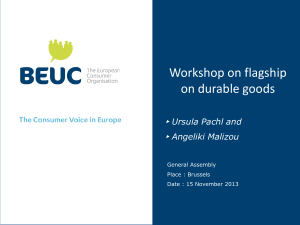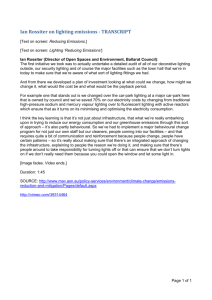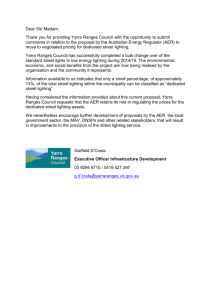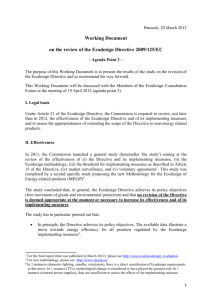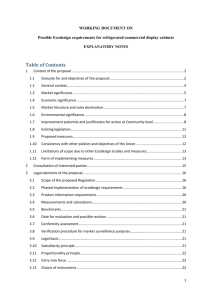Commission Staff Working Document
advertisement
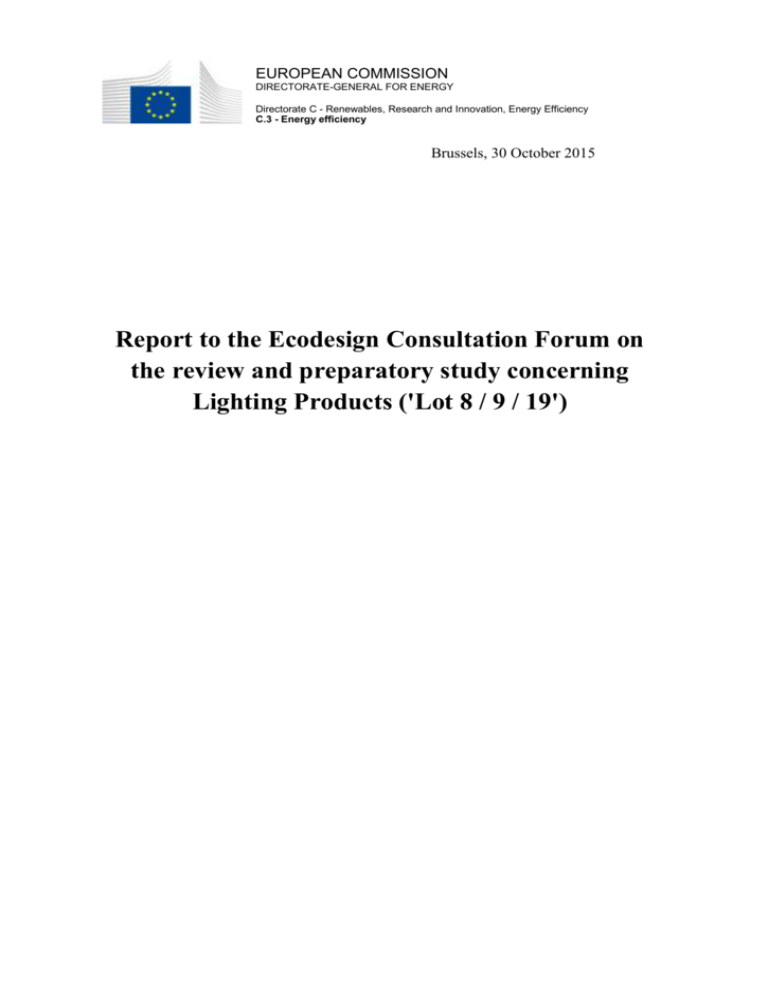
EUROPEAN COMMISSION
DIRECTORATE-GENERAL FOR ENERGY
Directorate C - Renewables, Research and Innovation, Energy Efficiency
C.3 - Energy efficiency
Brussels, 30 October 2015
Report to the Ecodesign Consultation Forum on
the review and preparatory study concerning
Lighting Products ('Lot 8 / 9 / 19')
1.
CONTEXT
Following the recommendations of the 'Omnibus Review'1, which was a combined
review of several regulations and one directive presented to the Ecodesign Consultation
Forum on 5 May 2014, it was decided to carry out a study on 'lighting products' (Lot
8/9/19) for the preparation of further ecodesign and energy labelling requirements.
The task of this study was therefore to build upon and advance Commission Regulation
(EC) No 244/20092, Commission Regulation (EC) No 245/20093, Commission
Regulation (EU) No 1194/20124, and Commission Delegated Regulation (EU) No
874/20125, and explore the feasibility of unifying all three ecodesign regulatory measures
into one novel regulation. To do so effectively, this study was also tasked to review
Regulations 874/2012 and 1194/2012 as legally required, and follow the MEErP 6,
extended in scope if necessary to fulfil the review requirements. The final version of the
study can be found here7.
Stakeholders from Member States authorities, industry, civil society and environmental
NGOs were actively involved since the beginning, and two public stakeholder meetings
were held. The study on lighting products was finalised in October 2015.
This report, in conjunction with the study on lighting products, fulfils the Commission's
obligation to review Regulations 874/2012 and 1194/2012, and to report on this to the
Consultation Forum.
1
The 'Omnibus Review' evaluated Commission Directive 96/60/EC, Commission Regulation (EC) No
107/2009, the remaining aspects of Commission Regulation (EC) No 244/2009, Commission
Regulation (EC) No 245/2009, Commission Regulation (EC) No 643/2009, Commission Regulation
(EC) No 1015/2010, Commission Regulation (EC) No 1016/2010, Commission Regulation (EC) No
1059/2010, Commission Regulation (EC) No 1060/2010, Commission Regulation (EC) No
1061/2010, and Commission Regulation (EU) No 547/2012.
2
Commission Regulation (EC) No 244/2009 of 18 March 2009 implementing Directive 2005/32/EC of the
European Parliament and of the Council with regard to ecodesign requirements for non-directional
household lamps
3
Commission Regulation (EC) No 245/2009 of 18 March 2009 implementing Directive 2005/32/EC of the
European Parliament and of the Council with regard to ecodesign requirements for fluorescent lamps
without integrated ballast, for high intensity discharge lamps, and for ballasts and luminaires able to
operate such lamps, and repealing Directive 2000/55/EC of the European Parliament and of the
Council
4
Commission Regulation (EU) No 1194/2012 of 12 December 2012 implementing Directive 2009/125/EC
of the European Parliament and of the Council with regard to ecodesign requirements for directional
lamps, light emitting diode lamps and related equipment
5
Commission Delegated Regulation (EU) No 874/2012 of 12 July 2012 supplementing Directive
2010/30/EU of the European Parliament and of the Council with regard to energy labelling of
electrical lamps and luminaires
6
Methodology for the ecodesign of energy-related products (MEErP) http://www.meerp.eu/
7
The study is publically accessible on the project website: http://ecodesign-lightsources.eu/documents
-2-
To facilitate discussions with stakeholders, a preliminary draft ecodesign regulation and a
preliminary draft energy labelling regulation based on the study's findings are attached.
Please note that the discussion on the framework Energy Labelling Regulation is still
ongoing, and some aspects such as the possible re-labelling of products already placed on
the market have not been incorporated. These two preliminary draft regulations should
therefore be seen as an initial starting point to facilitate discussion with Consultation
Forum members and the general public.
This report starts with a brief overview on the study's key findings and first thoughts
relevant to ecodesign. In the next chapter, key findings and first thoughts relevant for
energy labelling are discussed. The Consultation Forum's views on these are thought.
2.
ECODESIGN
The new ecodesign regulation should follow the approach to regulate as much as
necessary and as little as possible. To achieve this, the main idea behind the possible
draft ecodesign regulation attached for discussion is a necessary abstraction of the scope.
Defining specific lighting products through technical parameters has led to unintended
consequences such as loopholes, the regulation of non-intended products and the
omission of new technologies in the existing regulatory measures. To address these
problems, previous fixes involved an ever increasing complexity, which reduced
comprehensiveness and therefore increased the burden to comply and to verify this
compliance. Rather than increasing complexity, especially in the light of still developing
technologies such as light emitting diodes (LEDs) on organics LEDs (OLEDs), the
Commission services belief that easy-to-understand regulations covering only the
necessary aspects will improve compliance, verification and therefore the success of
these measures.
The products regulated, lamps and luminaires, can basically be separated into two useful
groups: lighting products and lighting product components8. A lighting product is the
entity of parts which can be operated, without any further modification, by connecting it
to the mains electricity network, and it has the primary function of emitting light. A
mains-voltage LED lamp, for example, is a lighting product.
A lighting product component is therefore a lighting product or a part thereof, which
needs to fulfil at least one of three possible functions:
- to transform electrical energy into light;
- to transform electricity by supplying a different voltage, limiting the electrical
current, or changing the current's directionality or frequency; and/or
- to control, process and/or regulate switching, luminous intensity and/or
chromaticity of the emitted light.
8
The exact proposed definition can be found in the accompanying draft ecodesign regulation.
-3-
Hence, a mains-voltage halogen lamp is a lighting product and a lighting product
component. A low-voltage halogen lamp is only a lighting product component – a further
lighting product component, a transformer, is necessary to have a lighting product.
A dimmer or sensor which is built into a luminaire with built in LEDs is part of a lighting
product, because the removal would require some modification – it is within one
package. On the other hand, a separate dimmer acting on a luminaire with build in LEDs,
which is otherwise connected to a mains line, is out of scope if the luminaire can be
operated without the dimmer.
These abstract definitions are technology neutral and independent of standards, yet cover
the products to be regulated sufficiently in conjunction with a clear scope defining
exclusions. This allows the draft regulation to operate without 'special purpose products',
removing a constant potential of past misuse. Indeed, the study shows that no exemptions
for general lighting applications will in general be necessary, because solid-state lighting
technologies will be ready to replace inefficient, old technologies. This also allows for
one common, technology neutral minimum energy efficiency requirement.
But this minimum energy efficiency threshold needs to be set with care; raising it too
ambitiously will hinder technological development and cost user satisfaction, and raising
it not at all or without the appropriate ambition will result in no policy effect. The
Ecodesign Directive therefore asks its implementing acts to set ecodesign requirements
according to least life-cycle costs (LLCC).
The study on lighting products shows that introducing more stringent ecodesign
requirements in two stages plus an effective redesign of the label (ECO80+120+label)
offers these LLCC lighting products and components emitting light:
While a more ambitious introduction of minimum energy efficiency requirements at an
earlier stage (ECO120+label) shows initially larger economic savings for consumers, it is
questionable if such an ambitious target would be realistic given the technological
development. Further, the savings are similar to the less rapid ECO80+120+label
scenario on the long rung.
-4-
While only a full Impact Assessment combined with insights from Consultation Forum
members can determine the correctness of these estimates, the Commission services
opted for the realistic ECO80+120+label scenario in its draft regulation accompanying
this report. This option is estimated to save approx. 61 TWh per year in 2030 compared
to a scenario without any further regulatory measures, and will have saved the EU28
consumers around €64 billion.
The ECO80+120+label scenario implies for ecodesign moving minimum energy
efficiency requirements to 80lm/W in 2020 and 120lm/W in 2024. For the regulation to
become effective before 2020 and fulfil its desired aim of removing regulatory
complexity and burden, an initial stage is required. The Commission services tentatively
propose a 60lm/W requirement in 2018, which would be just below the energy efficiency
requirement currently in force for frosted non-directional lamps, and the requirements to
enter into force in 2016 for non-filament directional lamps. Further, it would have no
significant negative effect on most tertiary lighting technologies, especially considering
the inclusion of a CRI bonus/malus, and be in line with the latest amending Commission
Regulation (EU) No 2015/14289 in that non-directional mains-voltage halogen lamps can
be placed on the Union's market until 1 September 2018.
3.
ENERGY LABELLING
An updated of the existing energy labelling Regulation 874/2012 is deemed desirable,
given the ongoing revision of the framework legislation, to ensure the continued success
of the energy label for lighting products, to advance the label in light of technological
progress, and to provide consistency with the ecodesign regulatory measure.
It is proposed to use the same abstraction of the scope: a revised energy labelling
regulation should cover lighting products and lighting product components emitting light
based on identical definitions. While an extension in scope, for example to cover battery
operated equipment or non-white light sources, would be possible, the positive
environmental effect might not outweigh the increased regulatory burden for
manufacturers but also market surveillance authorities.
The preliminary draft regulation focuses on light emitting products only. The
continuation of a separate label showing compatibility (the 'luminaire label') appears to
be unnecessary, because the phase-out of old technologies and continued market uptake
of solid-state technologies is expected to prevent future lock-in effects sufficiently. The
new energy label would therefore be more similar to the current 'lamp label'.
The study on lighting products offers insights into the possible requirements of a future
label. As an initial proposal, it proposes the following classes, which form the basis for
the preliminary draft energy label regulation:
9
Commission Regulation (EU) 2015/1428 of 25 August 2015 amending Commission Regulation (EC) No
244/2009 with regard to ecodesign requirements for non-directional household lamps and Commission
Regulation (EC) No 245/2009 with regard to ecodesign requirements for fluorescent lamps without
integrated ballast, for high intensity discharge lamps, and for ballasts and luminaires able to operate
such lamps and repealing Directive 2000/55/EC of the European Parliament and of the Council and
Commission Regulation (EU) No 1194/2012 with regard to ecodesign requirements for directional
lamps, light emitting diode lamps and related equipment
-5-
lm/W
EE Class
A
B
C
D
E
F
G
min
210
185
160
135
110
85
0
max
210
185
160
135
110
85
The application date of a new energy labelling regulation should correspond to the
application date of an updated ecodesign regulation; hence both are foreseen to become
applicable from 1 September 2018. Further, to enhance the effectiveness of the label, the
following changes are proposed:
- to increase the minimum size restrictions of the energy label;
- to tighten requirements on the prominence of the energy efficiency class, for
example by requiring this information to be mentioned at the start of any
information / advertisement text; and
- to show an indicator, such as the arrow of the energy efficiency class,
prominently on the package side, which is designed to face the consumer in a
store.
-6-

